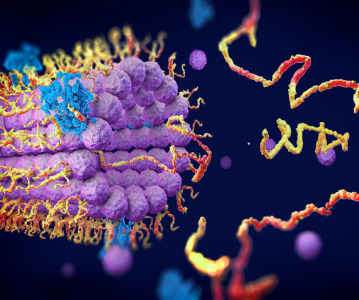Molecule shows ability to thwart pathogens’ genetic resistance to antibiotic

Bruce Geller, professor of microbiology, Oregon State University.
The molecule, which is a PPMO, will likely be ready for testing in humans in about 3 years.
Oregon State University (OSU) researchers have developed a new weapon in the battle against antibiotic-resistant germs - a molecule that neutralizes the bugs’ ability to destroy the antibiotic.
Scientists at OSU were part of an international collaboration that demonstrated the molecule’s ability to inhibit expression of an enzyme that makes bacteria resistant to a wide range of penicillins.
The molecule is a PPMO (peptide-conjugated phosphorodiamidate morpholino oligomer). The enzyme it combats is known as New Delhi metallo-beta-lactamase, or NDM-1, and it’s accompanied by additional genes that encode resistance to most, if not all, antibiotics.
“We’re targeting a resistance mechanism that’s shared by a whole bunch of pathogens,” said Bruce Geller, professor of microbiology in OSU’s College of Science and College of Agricultural Sciences, who’s been researching molecular medicine for more than a decade. “It’s the same gene in different types of bacteria, so you only have to have one PPMO that’s effective for all of them, which is different than other PPMOs that are genus specific.”
The Oregon State study showed that in vitro the new PPMO restored the ability of an antibiotic - in this case meropenem, an ultra-broad-spectrum drug of the carbapenem class - to fight three different genera of bacteria that express NDM-1. The research also demonstrated that a combination of the PPMO and meropenem was effective in treating mice infected with a pathogenic strain of E. coli that is NDM-1 positive.
Results of the study, supported by a grant from the National Institutes of Health, were recently published in the Journal of Antimicrobial Chemotherapy.
Geller says the PPMO will likely be ready for testing in humans in about 3 years.
“We’ve lost the ability to use many of our mainstream antibiotics,” Geller said. “Everything’s resistant to them now. That’s left us to try to develop new drugs to stay one step ahead of the bacteria, but the more we look the more we don’t find anything new. So that’s left us with making modifications to existing antibiotics, but as soon as you make a chemical change, the bugs mutate and now they’re resistant to the new, chemically modified antibiotic.”
That progression, Geller explains, made the carbapenems, the most advanced penicillin-type antibiotic, the last line of defense against bacterial infection.
“The significance of NDM-1 is that it is destroys carbapenems, so doctors have had to pull out an antibiotic, colistin, that hadn’t been used in decades because it’s toxic to the kidneys,” Geller said. “That is literally the last antibiotic that can be used on an NDM-1-expressing organism, and we now have bacteria that are completely resistant to all known antibiotics. But a PPMO can restore susceptibility to antibiotics that have already been approved, so we can get a PPMO approved and then go back and use these antibiotics that had become useless.”
In addition to Geller, the research team included Oregon State postdoctoral scholars Erin Sully and Lixin Li and OSU undergraduate student Christina Moody, as well as scientists from Sarepta Therapeutics, Harvard Medical School, the University of Fribourg, and the University of Texas Southwestern.
Related News
-
News CPHI Podcast Series: The power of proteins in antibody drug development
In the latest episode of the CPHI Podcast Series, Lucy Chard is joined by Thomas Cornell from Abzena to discuss protein engineering for drug design and development. -
News Amgen sues Samsung biologics unit over biosimilar for bone disease
Samsung Bioepis, the biologics unit of Samsung, has been issued a lawsuit brought forth by Amgen over proposed biosimilars of Amgen’s bone drugs Prolia and Xgeva. -
News CPHI Podcast Series: Why we need to consider women in clinical trials
The latest episode of the CPHI Podcast Series with Lucy Chard covers women's health, specifically women's representation in clinical trials, the associated bias, and the impacts on health for this population. -
News US FDA does not approve MDMA therapy for PTSD, requests more data
The MDMA-based therapeutic developed by Lykos Therapeutics, a California-based Public Benefit Corporation (PBC), has been reviewed and unapproved by the US FDA. The regulator has requested additional phase III trial data for further safety and efficacy... -
News Novartis and Viatris latest facing lawsuit over HeLa cell misuse
Global pharmaceutical companies Novartis and Viatris are the latest hit with a lawsuit claim pertaining to alleged misuse of the ‘HeLa’ cell line from the estate of woman whose cancerous tissue cells were taken without consent. -
News Sanofi invests billions into Frankfurt insulin production site
French pharmaceutical company Sanofi have announced an investment of EUR1.3 billion at their existing BioCampus site in Frankfurt am Main for the expansion of insulin production. -
News Novel oral Type 1 diabetes drug gains US FDA IND designation
A University of Alabama at Birmingham startup has gained FDA clearance for Investigational New Drug clinical trials for an oral Type 1 diabetes drug, a milestone for diabetes treatment. -
News A Day in the Life of a Vice President in R&D & Engineering
In the Day in the Life of Series, we've already had the chance to get to know a range of people in various roles in the pharma industry. In the latest interview we get a glimpse into the R&D side of things from Jennifer Sorrells, Vice Presiden...
Position your company at the heart of the global Pharma industry with a CPHI Online membership
-
Your products and solutions visible to thousands of visitors within the largest Pharma marketplace
-
Generate high-quality, engaged leads for your business, all year round
-
Promote your business as the industry’s thought-leader by hosting your reports, brochures and videos within your profile
-
Your company’s profile boosted at all participating CPHI events
-
An easy-to-use platform with a detailed dashboard showing your leads and performance

.png)

.png)
.png)
.png)
.png)
